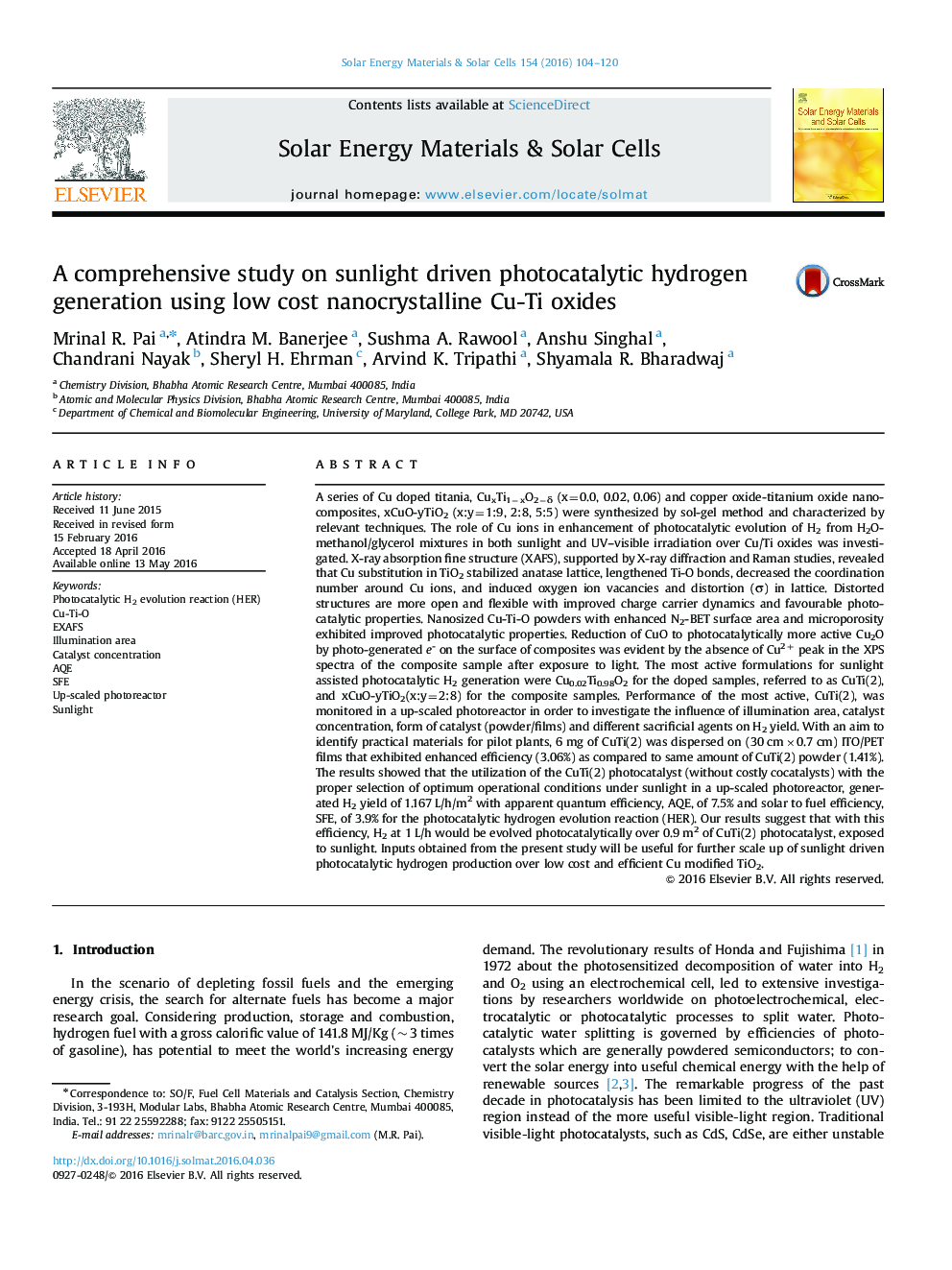| کد مقاله | کد نشریه | سال انتشار | مقاله انگلیسی | نسخه تمام متن |
|---|---|---|---|---|
| 77568 | 49286 | 2016 | 17 صفحه PDF | دانلود رایگان |
• Photocatalytic H2 overCuxTi1−xO2, CuO-TiO2 and CuTi/ITO/PET under sunlight.
• Favourable morphology and bulk properties of Cu/Ti enhanced H2 yield.
• Performance of most active photocatalyst in upscaled photoreactors.
• Influence of illumination area, catalyst loading, form of catalyst on H2 yield.
• Sunlight driven H2@1.167 L/h/m2 generated over Cu0.02Ti0.98O2−δ.
A series of Cu doped titania, CuxTi1−xO2−δ (x=0.0, 0.02, 0.06) and copper oxide-titanium oxide nanocomposites, xCuO-yTiO2 (x:y=1:9, 2:8, 5:5) were synthesized by sol-gel method and characterized by relevant techniques. The role of Cu ions in enhancement of photocatalytic evolution of H2 from H2O-methanol/glycerol mixtures in both sunlight and UV–visible irradiation over Cu/Ti oxides was investigated. X-ray absorption fine structure (XAFS), supported by X-ray diffraction and Raman studies, revealed that Cu substitution in TiO2 stabilized anatase lattice, lengthened Ti-O bonds, decreased the coordination number around Cu ions, and induced oxygen ion vacancies and distortion (σ) in lattice. Distorted structures are more open and flexible with improved charge carrier dynamics and favourable photocatalytic properties. Nanosized Cu-Ti-O powders with enhanced N2-BET surface area and microporosity exhibited improved photocatalytic properties. Reduction of CuO to photocatalytically more active Cu2O by photo-generated e- on the surface of composites was evident by the absence of Cu2+ peak in the XPS spectra of the composite sample after exposure to light. The most active formulations for sunlight assisted photocatalytic H2 generation were Cu0.02Ti0.98O2 for the doped samples, referred to as CuTi(2), and xCuO-yTiO2(x:y=2:8) for the composite samples. Performance of the most active, CuTi(2), was monitored in a up-scaled photoreactor in order to investigate the influence of illumination area, catalyst concentration, form of catalyst (powder/films) and different sacrificial agents on H2 yield. With an aim to identify practical materials for pilot plants, 6 mg of CuTi(2) was dispersed on (30 cm×0.7 cm) ITO/PET films that exhibited enhanced efficiency (3.06%) as compared to same amount of CuTi(2) powder (1.41%). The results showed that the utilization of the CuTi(2) photocatalyst (without costly cocatalysts) with the proper selection of optimum operational conditions under sunlight in a up-scaled photoreactor, generated H2 yield of 1.167 L/h/m2 with apparent quantum efficiency, AQE, of 7.5% and solar to fuel efficiency, SFE, of 3.9% for the photocatalytic hydrogen evolution reaction (HER). Our results suggest that with this efficiency, H2 at 1 L/h would be evolved photocatalytically over 0.9 m2 of CuTi(2) photocatalyst, exposed to sunlight. Inputs obtained from the present study will be useful for further scale up of sunlight driven photocatalytic hydrogen production over low cost and efficient Cu modified TiO2.
Figure optionsDownload as PowerPoint slide
Journal: Solar Energy Materials and Solar Cells - Volume 154, September 2016, Pages 104–120
